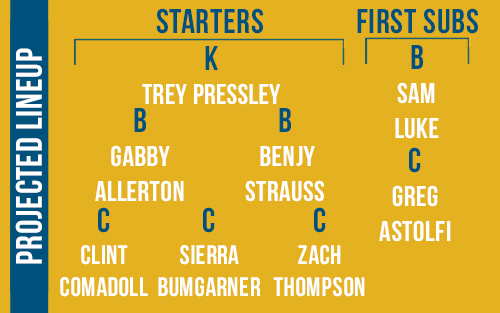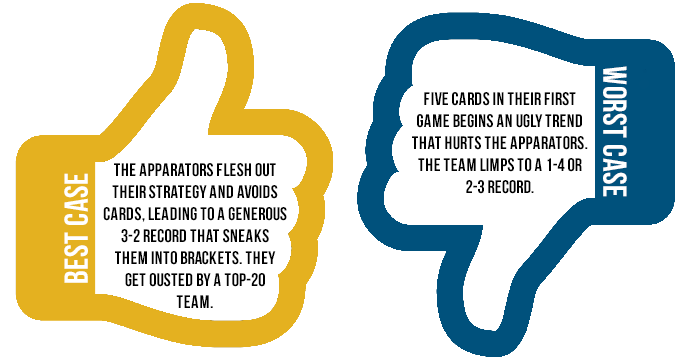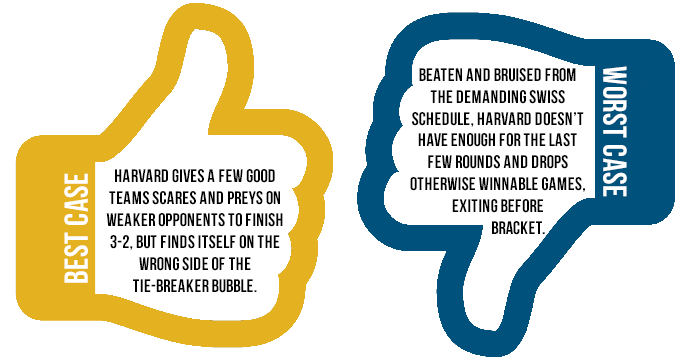Antwerp QC, Much of Belgian Core, Leaves Competitive Quidditch
Rock Hill Roll Call is your in-depth guide to the 80 teams that will compete for the title of World Cup 8 Champion. We’ve reached out to writers and analysts all over the country to bring you the lineups, strategies, focal points and aspirations of each and every attending team. Whether you are looking for a leg up on the competition or just want a detailed preview of the sport’s main event, this is the place for you.
 By Max Miceli
By Max Miceli
The Appalachian Apparators roster is filled with raw athleticism. Here’s the problem though: Nearly every one of those raw athletes is a chaser. While the team can run and hit with just about any other team, the Apparators are vulnerable to even below-average beating corps by World Cup standards, and it doesn’t help that the Apparators’ strategy and game-planning seems to be lacking as well.
With all the team’s pure strength and speed, you’d expect them to be a tough  outing, but the team’s lack of experience leads to a lot of cards—and I mean a lot—that makes it tough for the Apparators to win against top-notch opponents.
outing, but the team’s lack of experience leads to a lot of cards—and I mean a lot—that makes it tough for the Apparators to win against top-notch opponents.
In order for the Apparators to see success at World Cup, and possibly even sneak their way into brackets, the team will need its leaders Trey Pressley, Abbi Pittman, Sam Luke and Greg Astolfi to do their due diligence. If these individuals can find a way to maximize the team’s pure talent, they can get to a 3-2 record and make it past pool play. The question is whether or not they can reel in their young group.
This squad’s leaders are uniquely challenged with being unfortunately positioned far away from just about all top-notch competition, making it difficult to learn and progress as a team schematically. So if the Apparators are going to improve, it’s likely going to happen from watching and analyzing a lot of film and involve a lot of coaching to help the young players hone their talent and avoid cards.
 By Anonymous
By Anonymous
These kids don’t totally know what they’re doing, but they’re not small and they can hit. Their defense is very reliant on their point defender making tackles, which creates problems against teams with ball carriers who are strong drivers. They typically play their beaters around the keeper zone and have them pick off passing options so the chasers can collapse on the quaffle carrier. This works for them more often than not because, as the previous author mentioned, they have some bros that love to hit.
Offensively, the team still seems to be figuring itself out. They have a slew of athletes who can all drive and love trucking through smaller defenders, but they generally struggle against point-beater strategies like the one University of Maryland used to hold them to a total of 30 quaffle points in two games at Turtle Cup. By attacking the Apparators’ quaffle carriers with a beater, teams can force passes through this squad’s more mediocre ball distributors and frustrate the offense on the whole.
Once you start to frustrate their young athletes, it’s all downhill from there for this youthful team. Inexperience and frustration has consistently led to cards for the Apparators, and once the cards start coming out, no team can keep up with World Cup-caliber talent and win games.
 By Ethan Sturm
By Ethan Sturm
If finding team-carrying levels of talent right when needed was a quantifiable stat, the Harvard University Horntails would be at the top of the class. For years, the Horntails were the Andrew Murray show, dependent on an incredibly talented chaser that somehow managed to receive no recognition for years until moving out west and immediately thrusting himself into the upper echelons of chasers in the region while playing for the Long Beach Funky Quaffles and the LA Gambits.
After Murray’s graduation, Harvard had a gaping hole to fill and hit the jackpot when Jon Jackson, then a junior, decided to join the team. The two stand in staunch contrast to each other–Murray, a diminutive pinball that used his agility and low center of gravity to zip through opposing defenses and make strong tackles and Jackson, a tall, broad-shouldered athlete that looks the part and plays it as well–but each quickly learned how to put a team on their backs.
Jackson made the move to full-time keeper this season, and his contributions on both sides of the ball have been tangible. In the team’s season opener against Emerson College, Jackson stuffed David Fox three times, point blank at the hoops. In perhaps the team’s most impressive performance of the year–a 110*-90 loss to Boston University at Northeast Classic, Jackson was nearly unstoppable, constantly going through an entire, highly-physical Terriers defense–with bludger control, no less–to continue to put points on the board. When bloody knees briefly forced him out of the game, he stepped to the sideline, tied a sock around each knee, and immediately reentered on the pitch. Harvard’s success revolves around Jackson, and whether or not he’ll admit it, he undoubtedly knows it.
on both sides of the ball have been tangible. In the team’s season opener against Emerson College, Jackson stuffed David Fox three times, point blank at the hoops. In perhaps the team’s most impressive performance of the year–a 110*-90 loss to Boston University at Northeast Classic, Jackson was nearly unstoppable, constantly going through an entire, highly-physical Terriers defense–with bludger control, no less–to continue to put points on the board. When bloody knees briefly forced him out of the game, he stepped to the sideline, tied a sock around each knee, and immediately reentered on the pitch. Harvard’s success revolves around Jackson, and whether or not he’ll admit it, he undoubtedly knows it.
This year’s edition of the Harvard star-finder roulette landed the team Jeremy Ferlic, who started grad school at Harvard in the fall after an impressive tenure as Miami University’s star beater. Ferlic brings a level of skill to the bludger game that the Horntails have never had in program history. Working in two-male beater sets, Ferlic was able to clear massive holes for Jackson to go to work in. With another semester to train, Ferlic with have to be a breakout force if Harvard is to have a noteworthy World Cup.
Harvard has never had the biggest program, but year after year they seem to dig just enough of a treasure chest of talent to get by. With Jackson, Ferlic and chaser/seeker Hank Smith more experienced than ever, and chaser Carli Haggerty returning to the team, Rock Hill’s iteration of the Horntails may be the strongest the school has ever put on a quidditch pitch. Whether it will be enough, particularly in a format that rewards depth, remains to be seen.
 By Ethan Sturm
By Ethan Sturm
At the Northeast Regional Championship, Harvard joined the rest of the Northeast in adding a heavy dose of two-male beater sets to their game plan. While their male beaters played well and became a major factor in their eventual qualification, their female chasers struggled in their increased role, often forcing keeper Jackson into a two-man offense with whatever male chaser the team had on the field. Even when the team wasn’t in such a set, the passing options were limited.
Enter–or, actually, re-enter–Haggerty, the six-foot former high school basketball star that made a name for herself as a rookie before shipping off to Cuba for the duration of this past semester. Haggerty’s height and length make her a difficult assignment for just about any opposing female chaser in the league and also make her a tough defender to fit a pass back. Over the summer in pickup games, she was able to regularly take Team USA’s Hannah DeBaets out as an option offensively by dwarfing her around the hoops.
The biggest question surrounding Haggerty is how long it will take her to return to her prior form after taking five months off from the sport. While certain things, like defensive play, will likely come naturally, confidence in positioning and finishing around the hoops offensively is something that can take some work to reestablish. And the Boston winter likely won’t be doing her any favors, with massive snowfalls regularly halting quidditch within the city in the lead-up to World Cup.
The team will also likely need an increase in physical play from her, especially if they hope to continue to sit in two-male beater sets against top teams. While Haggerty is tall, she’s also on the lankier side and will have to prove that she is capable of making the kind of tackles that would allow Harvard to trust her to step to point or make an open-field, fast break-stopping tackle when needed.
Last April, Harvard was a snitch grab away–in their match against Tennessee Tech Quidditch–from winning a World Cup pool that included University of Maryland. The team has shown flashes of that type of play over the course of the fall semester–but with a more consistent, talented beating core. However, the squad has also shown it can be limited offensively by a savvy defense that focuses its attention on Jackson, forces him to pass and takes away his one passing option. With Haggerty prowling around the hoops, though, teams will be forced to man-up more honestly, allowing Jackson to go to work with the ball in his hands, a dangerous prospect for even the most talented of teams.
Harvard has never been known for depth of players–or depth of talent–and Haggerty’s return brings a valuable injection of both. While she won’t have the effect Jackson will on a play-to-play basis, her effectiveness will go a long way in determining just how successful this team can be in Rock Hill.
Archives by Month:
- May 2023
- April 2023
- April 2022
- January 2021
- October 2020
- September 2020
- July 2020
- May 2020
- April 2020
- March 2020
- February 2020
- January 2020
- December 2019
- November 2019
- October 2019
- August 2019
- April 2019
- March 2019
- February 2019
- January 2019
- November 2018
- October 2018
- September 2018
- August 2018
- July 2018
- June 2018
- April 2018
- March 2018
- February 2018
- January 2018
- November 2017
- October 2017
- July 2017
- June 2017
- May 2017
- April 2017
- March 2017
- February 2017
- January 2017
- December 2016
- November 2016
- October 2016
- September 2016
- August 2016
- July 2016
- June 2016
- May 2016
- April 2016
- March 2016
- February 2016
- January 2016
- December 2015
- November 2015
- October 2015
- September 2015
- August 2015
- July 2015
- June 2015
- May 2015
- April 2015
- March 2015
- February 2015
- January 2015
- December 2014
- November 2014
- October 2014
- September 2014
- August 2014
- July 2014
- May 2014
- April 2014
- March 2014
- February 2014
- January 2014
- November 2013
- October 2013
- September 2013
- August 2013
- July 2013
- June 2013
- May 2013
- April 2013
- March 2013
- February 2013
- January 2013
- December 2012
- November 2012
- October 2012
Archives by Subject:
- Categories
- Awards
- College/Community Split
- Column
- Community Teams
- Countdown to Columbia
- DIY
- Drills
- Elo Rankings
- Fantasy Fantasy Tournaments
- Game & Tournament Reports
- General
- History Of
- International
- IQA World Cup
- Major League Quidditch
- March Madness
- Matches of the Decade
- Monday Water Cooler
- News
- Positional Strategy
- Press Release
- Profiles
- Quidditch Australia
- Rankings Wrap-Up
- Referees
- Rock Hill Roll Call
- Rules and Policy
- Statistic
- Strategy
- Team Management
- Team USA
- The Pitch
- The Quidditch Lens
- Top 10 College
- Top 10 Community
- Top 20
- Uncategorized
- US Quarantine Cup
- US Quidditch Cup





